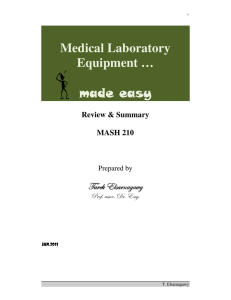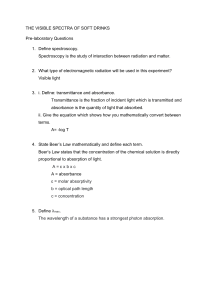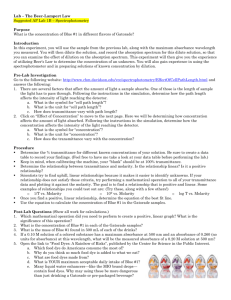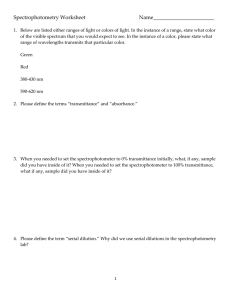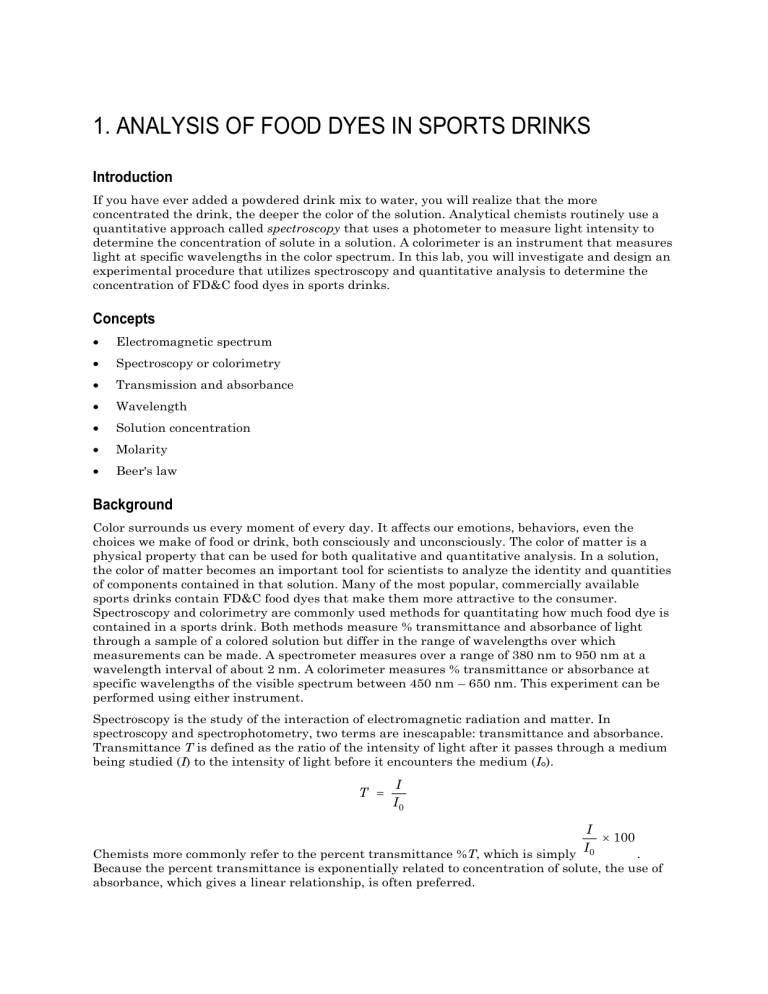
1. ANALYSIS OF FOOD DYES IN SPORTS DRINKS Introduction If you have ever added a powdered drink mix to water, you will realize that the more concentrated the drink, the deeper the color of the solution. Analytical chemists routinely use a quantitative approach called spectroscopy that uses a photometer to measure light intensity to determine the concentration of solute in a solution. A colorimeter is an instrument that measures light at specific wavelengths in the color spectrum. In this lab, you will investigate and design an experimental procedure that utilizes spectroscopy and quantitative analysis to determine the concentration of FD&C food dyes in sports drinks. Concepts • Electromagnetic spectrum • Spectroscopy or colorimetry • Transmission and absorbance • Wavelength • Solution concentration • Molarity • Beer's law Background Color surrounds us every moment of every day. It affects our emotions, behaviors, even the choices we make of food or drink, both consciously and unconsciously. The color of matter is a physical property that can be used for both qualitative and quantitative analysis. In a solution, the color of matter becomes an important tool for scientists to analyze the identity and quantities of components contained in that solution. Many of the most popular, commercially available sports drinks contain FD&C food dyes that make them more attractive to the consumer. Spectroscopy and colorimetry are commonly used methods for quantitating how much food dye is contained in a sports drink. Both methods measure % transmittance and absorbance of light through a sample of a colored solution but differ in the range of wavelengths over which measurements can be made. A spectrometer measures over a range of 380 nm to 950 nm at a wavelength interval of about 2 nm. A colorimeter measures % transmittance or absorbance at specific wavelengths of the visible spectrum between 450 nm – 650 nm. This experiment can be performed using either instrument. Spectroscopy is the study of the interaction of electromagnetic radiation and matter. In spectroscopy and spectrophotometry, two terms are inescapable: transmittance and absorbance. Transmittance T is defined as the ratio of the intensity of light after it passes through a medium being studied (I) to the intensity of light before it encounters the medium (Io). T = I I0 I 100 I0 Chemists more commonly refer to the percent transmittance %T, which is simply . Because the percent transmittance is exponentially related to concentration of solute, the use of absorbance, which gives a linear relationship, is often preferred. A = − log T = − log I I0 Note that A = –2 log (%T). If one knows the percent transmittance, one can calculate absorbance and vice versa. Most modern spectrophotometers have both a %T and an absorbance scale. With a digital instrument, it is simply a matter of changing modes to display either value. Beer’s law is one of the most fundamental and widely applied spectroscopic laws. It relates the absorbance of light to the concentration (c) of the solute, the optical path length (b) and the molar absorptivity (a) of a solution. An operation statement of Beer’s Law can be represented as A = abc The molar absorptivity is a constant that depends on the nature of the absorbing solution system and the wavelength of the light passing through it. A plot that shows the dependence of A on wavelength is called a spectrum. Materials and Equipment Use the following materials to complete the initial investigation. For conducting an experiment of your own design, check with your teacher to see what materials and equipment are available. • Data collection system • Test tubes and racks • Wireless colorimeter • FD&C Blue # 1 food dye stock solution • Plastic cuvettes • Distilled water in wash bottle • Plastic transfer pipettes or eyedroppers • Sport drink or Kool-Aid® with FD&C Blue # 1 • 10 mL graduated cylinder food dye Safety Follow these important safety precautions in addition to your regular classroom procedures: • Wear safety goggles at all times • Avoid direct contact of FD&C dyes with skin, eyes and clothing. • Wash hands thoroughly with soap and water before leaving laboratory Initial Investigation Determination of Optimal Wavelength for Measuring Absorbance of FD&C Blue # 1 1. Using a sample of the stock solution of FD&C Blue 1 food dye provided to you by your instructor, determine the optimal wavelength for measuring absorbance of FD&C Blue 1 food dye. 2. Start a new experiment on the data collection system from your Chromebook, computer or mobile device. 3. Connect the colorimeter to the data collection system. SparkVue was used for this analysis. 4. Select “Absorbance and Transmittance” from the Quick Start Lab menu or open lab file 01 Analysis of Food Dyes in Sports Drinks. Calibrate the colorimeter using distilled water. You should read zero for absorbance and 100% for transmittance. 5. Measure absorbance of your dye sample at the different wavelengths. Determine the wavelength that gives the maximum absorbance. Calibration Curve of FD&C Blue # 1 Food Dye Prepare a series of dilutions of FD&C Blue 1 food dye from a stock solution of known concentration prepared for you by your instructor, and distilled water. Prepare 10 mL of each dilution, calculate and record the concentration of each sample in the table below. Using a colorimeter, you will measure absorbance of each solution in the Initial Activity. Table 1: Calibration Curve of Stock FD&C Blue # 1 (Absorbance at 600 nm) Blue #1 Sample Stock Solution (mL) Distilled Water (mL) 1 10 0 2 8 2 3 6 4 4 4 6 5 3 7 6 2 8 7 1 9 8 0 10 Concentration2 (M) Absorbance (-log T) %Transmittance 6. Start a new experiment on the data collection system from your Chromebook, computer or mobile device. 7. Connect the colorimeter to the data collection system. 8. Select “Absorbance and Transmittance” from the Quick Start Lab menu or go to page 2 of the lab file. Calibrate the colorimeter using distilled water. You should read zero for absorbance and 100% for transmittance. 9. Transfer prepared dilutions to cuvettes, filling to three-fourths full. Using the most concentrated solution, insert into the cuvette port of the colorimeter and record the absorbance data. Remember that the cuvettes must be handled by the ribbed sides. 10. Of the given wavelengths of light, determine the optimum wavelength that demonstrates your sample’s maximal absorbance. What do you notice about the wavelength of highest absorbance? Hint: Consider the color wheel of complementary colors. 11. Save your data and start a new experiment by selecting Beer’s Law from the Quick Start Menu. Adjust the absorbance wavelength if needed. 12. Measure and record the absorbance of your first dilution sample at the optimal wavelength. Enter the calculated dye concentration in moles/L (M). Press the green “check” mark to record the reading. 13. Remove the cuvette from the colorimeter and replace with a second sample. Repeat the necessary steps to test the remaining dye dilution samples. 14.When completed, stop data collection and save your experiment. Use SparkVue’s graphing tools to determine the linearity of your calibration curve. 15. Record all absorbance data in the prepared table above. 16. Convert y-axis in data table to Transmittance at 600 nm and record the corresponding % Transmittance (%T) in the prepared table. Advanced Investigation To further support your understanding of the graphical relationships between absorbance and transmittance, complete Table 2 using the data set from Table 1. Table 2: Graphical Analysis of Absorbance and Transmittance of FD&C Blue Dye # 1 (600 nm) Blue Dye # 1 Sample Concentration (M) %T Transmittance (T) log T Absorbance (-log T) 1 2 3 4 5 6 7 8 1. Prepare separate graphs of (a) %T, (b) T, (c) log T and (d) -log T as y-axis values and molar concentrations of food dye as the x-values. Remember that the value for transmittance (T) is percent transmittance (%T) written in decimal form. Using SPARKVue’s analytical tools, determine which curve has the best linear fit. Which graph has the most linear and positive slope? 2. Obtain a sports drink containing FD&C Blue # 1 dye. You may choose a ready-to-drink product or prepare one from a powdered mix according to manufacturer’s instructions. Using the procedure from the Initial Investigation and graphs produced in the graphing challenge above, develop an experimental protocol to measure the concentration of FD&C Blue # 1 dye in your chosen drink using the optimal calibration method that gives the best linear correspondence for quantitative analysis. 3. Unlike your dye dilution samples which contained only dye and water, the typical sport drink formulation contains other ingredients which may include sugar and electrolytes. What effect will the presence of additional ingredients potentially have on the quantitative determination of the food dye content? 4. Measure the absorbance and % transmittance of your sports drink. Do the numbers fall within the range of your calibration curve? If not, what should you do to fix this? 5. Determine the concentration of the dye in your beverage and calculate the mass of dye (mg/L) of the sports drink. FD&C Blue # 1 dye has a molar mass of 793 g/mole. Extended Inquiry Investigation Following the procedures used above, similar investigations can be conducted to investigate the dye content of other food dyes in other drinks. Two common dyes are FD&C Red # 40 and FD&C Yellow # 5. The structures and molar masses of these dyes are shown below. Measure the visible spectra of FD&C Red # 40 and FD&C Yellow # 5 and determine the wavelength for each dye that gives maximal absorbance. Compare your absorbance data with that observed for FD&C Blue # 1. What trend(s) do you notice? Formulate a possible explanation for your observations that correlates the molecular structure of the food dye and absorbance wavelength. Determine the concentration of the food dye in the red and/or yellow sports drinks using Beer’s law.
